Abstract
The role of skin and muscle vascular beds in baroreceptor-mediated alterations of peripheral vascular resistance was evaluated in six normal subjects in whom the skin circulation in one forearm was temporarily suppressed by epinephrine iontophoresis. Baroreceptor activity was enhanced by application of negative pressure to the neck (neck suction) and inhibited by application of lower body negative pressure. Forearm blood flow was measured simultaneously in both arms with strain gauge plethysmographs. Since blood flow in the treated arm consisted entirely of muscle flow, skin flow was calculated from the difference between total forearm flow in the intact arm and muscle flow in the treated arm. Vascular resistances were calculated as the ratio of mean arterial pressure to the blood flow of each vascular bed. During neck suction, mean arterial pressure decreased from an average of 89 to 75 mm of Hg (P < 0.005), heart rate decreased from an average of 60 to 55 beats/min (P < 0.005), and total skin and muscle flows remained essentially unchanged. Cutaneous vascular resistance decreased from an average of 75 to 49 mm of Hg/ml per 100 g per min (P < 0.05), muscle vascular resistance from 68 to 51 (P < 0.005), and total forearm vascular resistance from 36 to 24 (P < 0.025). During lower body negative pressure, heart rate increased from an average of 59 to 69 beats/min (P < 0.005), mean arterial pressure did not change significantly, and significant decreases occurred in forearm blood flow from 5.4 to 2.7 ml/100 g per min, in skin blood flow from 3.1 to 1.4, and in muscle blood flow from 2.3 to 1.3. Cutaneous vascular resistance increased from an average of 47 to 110 mm of Hg/ml per 100 g per min (P < 0.05), muscle vascular resistance from 43 to 72 (P < 0.005), and total forearm vascular resistance from 20 to 38 (P < 0.001). These results demonstrate that both the skin and muscle resistance vessels participate in reflex changes initiated by alterations in baroreceptor activity.
Full text
PDF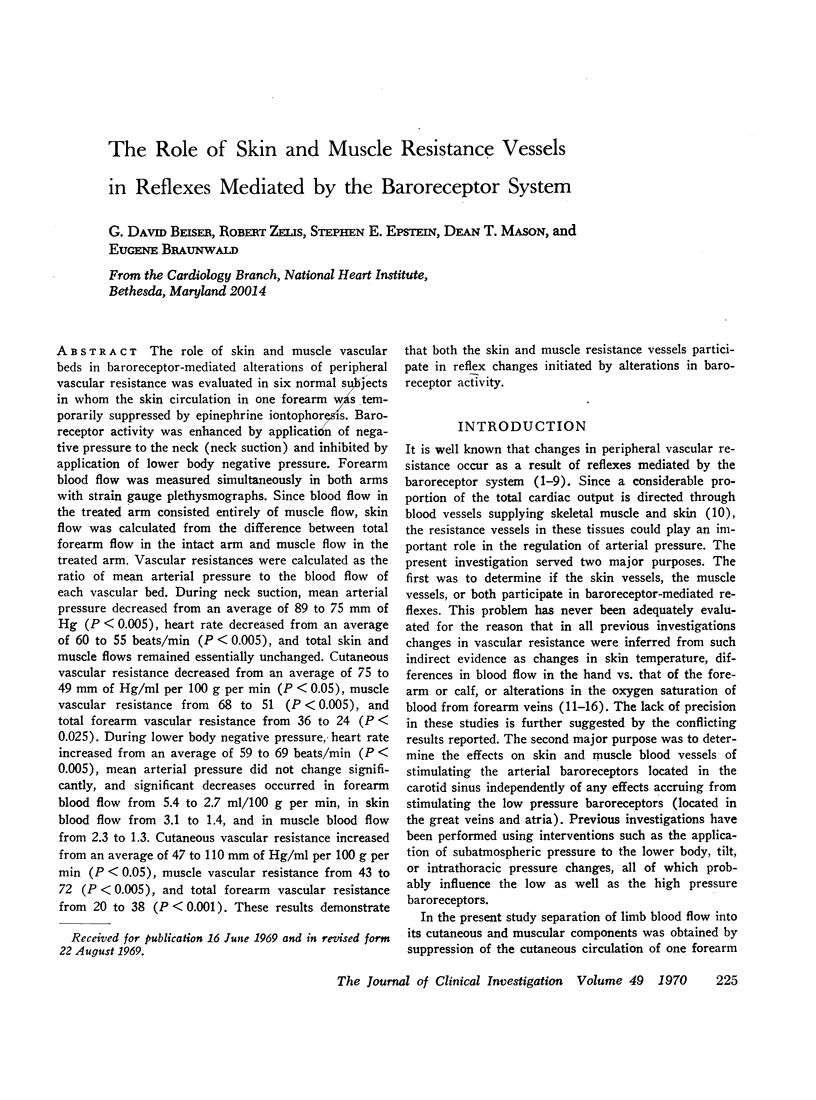
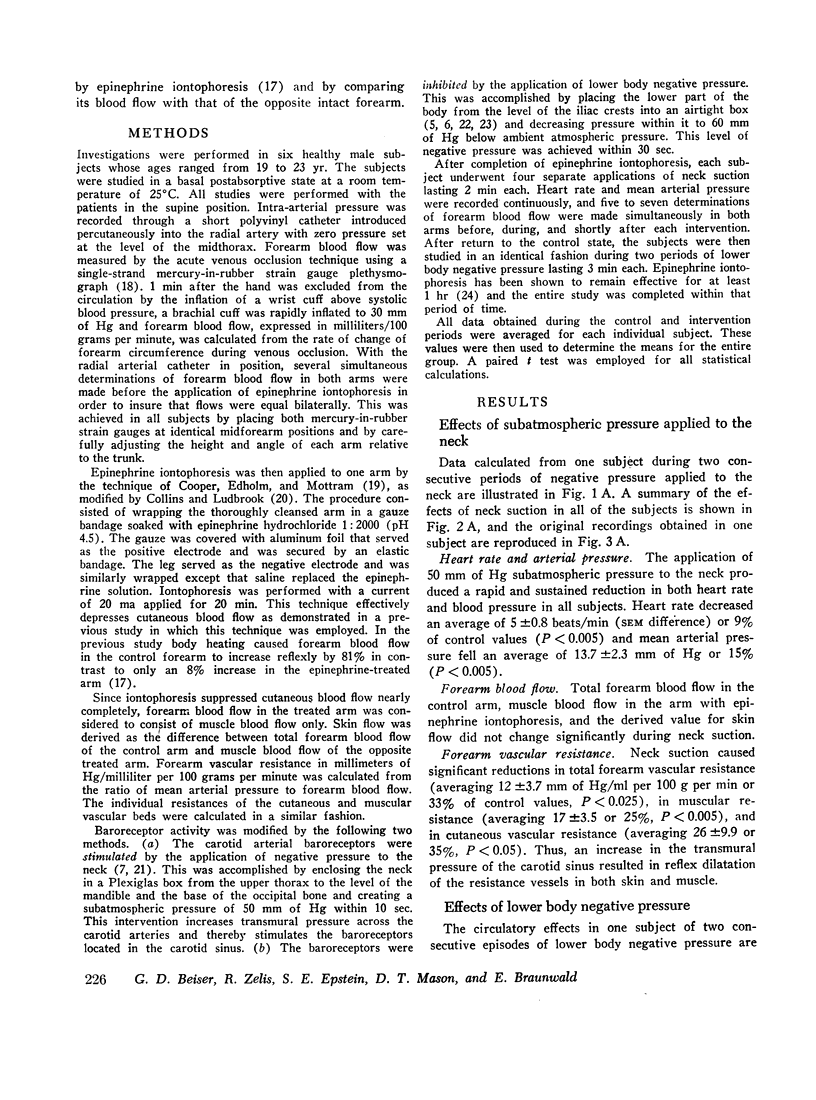
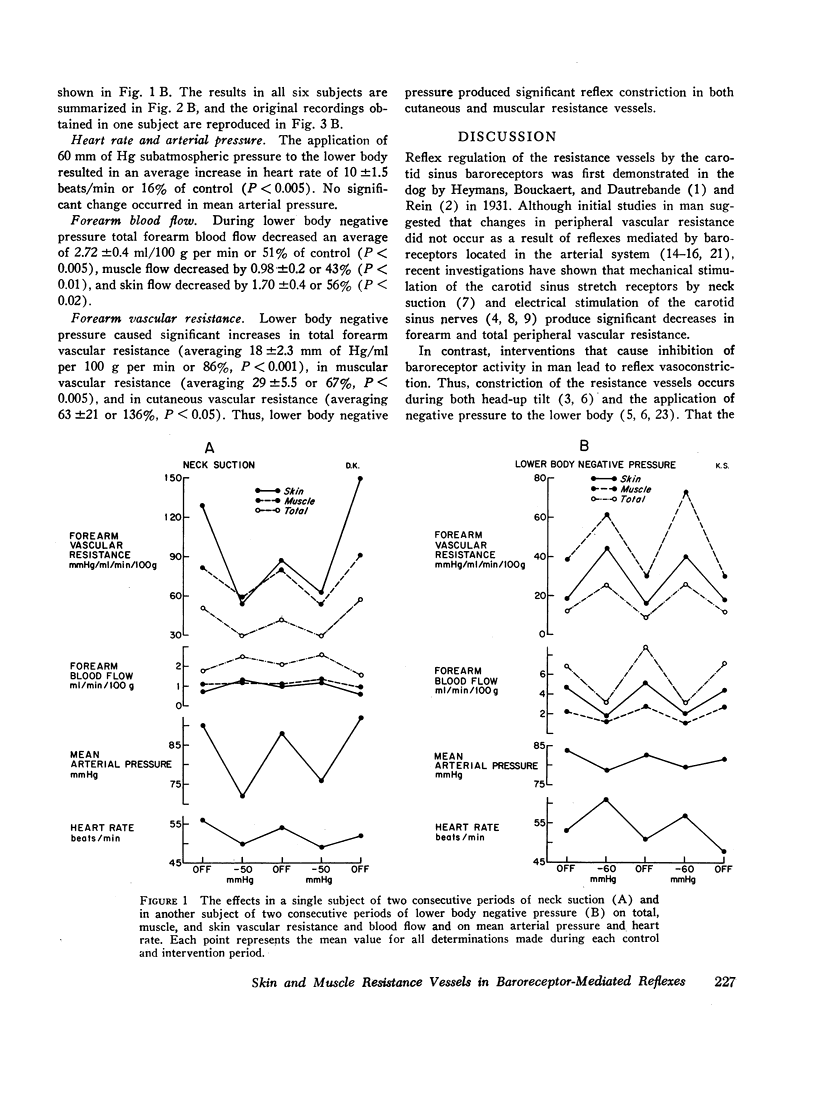
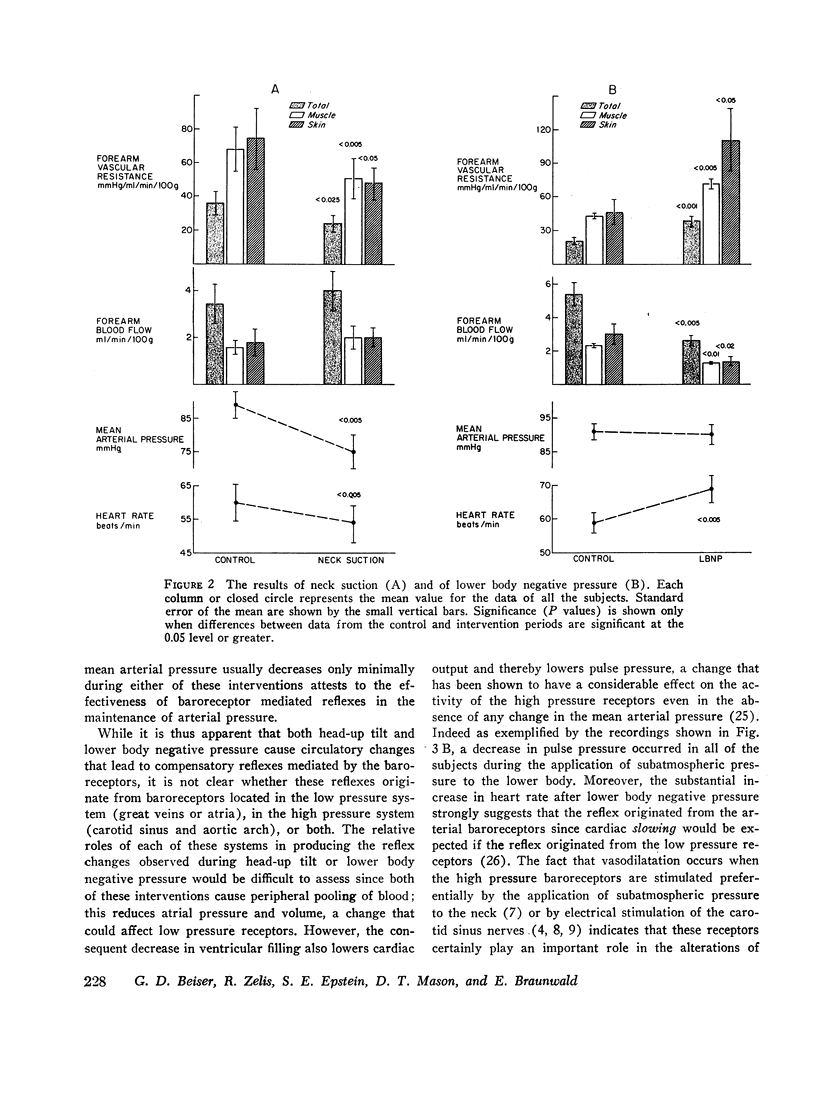
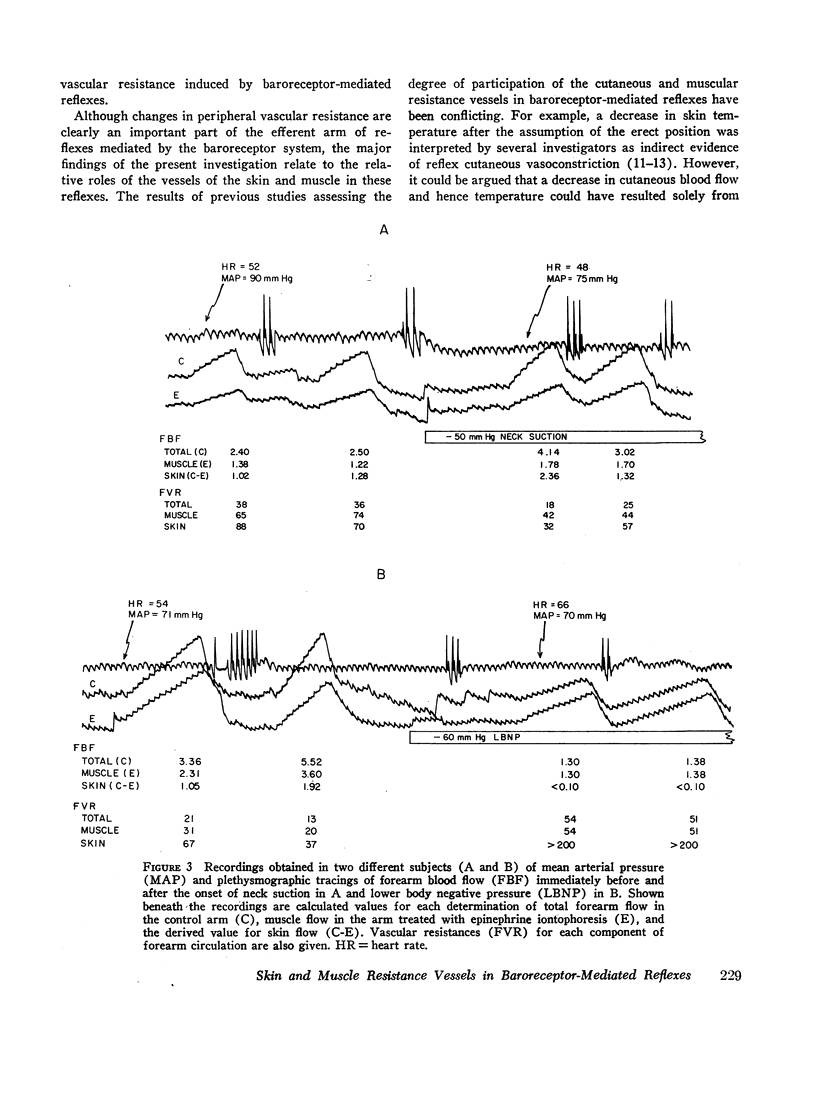
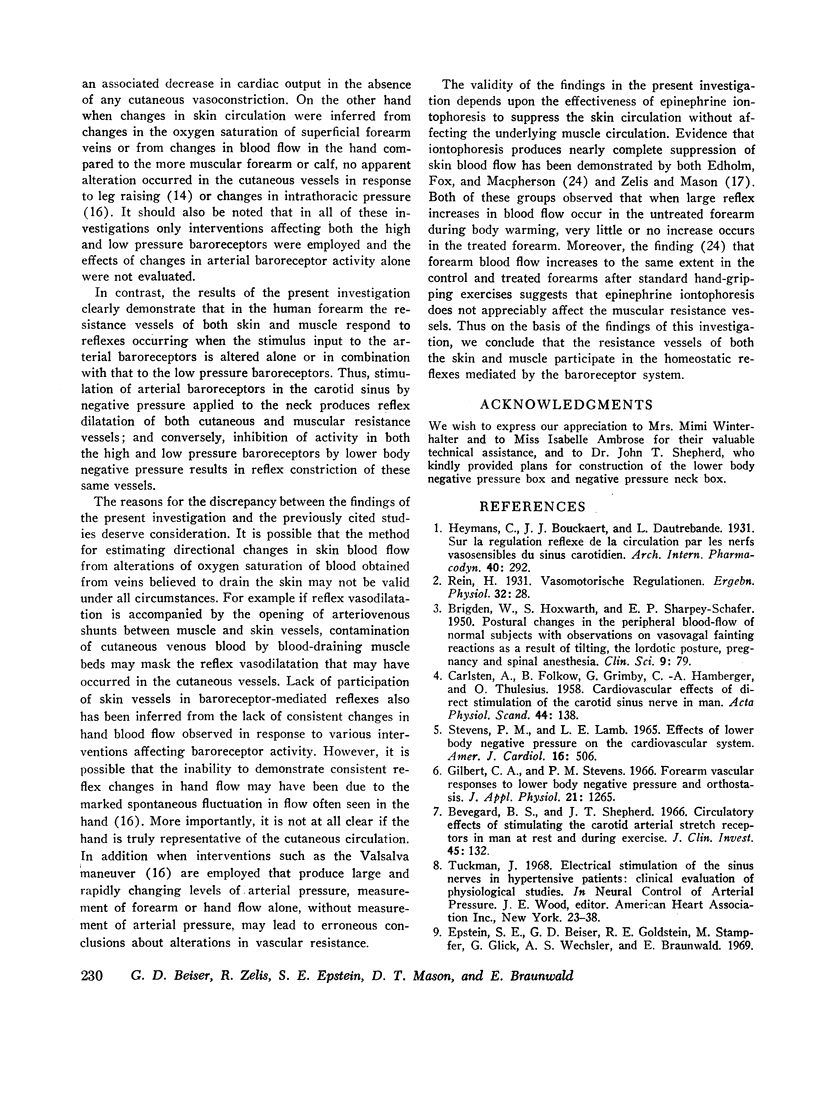
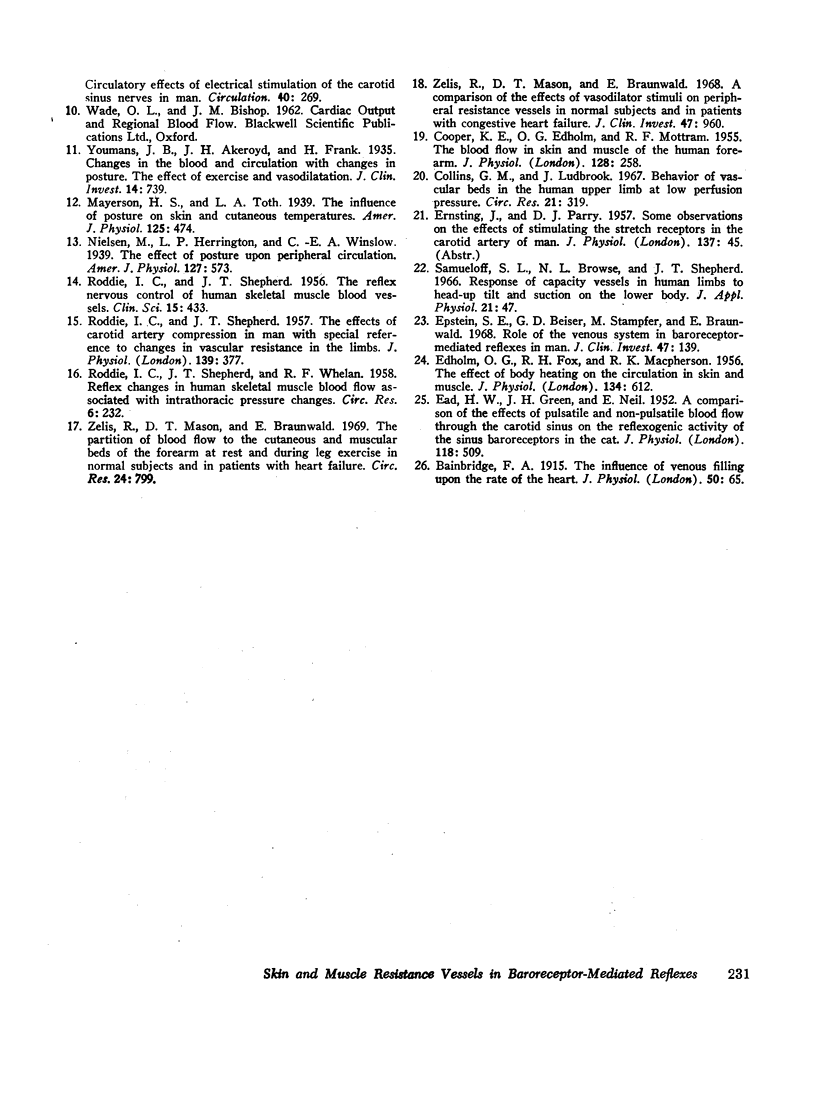
Selected References
These references are in PubMed. This may not be the complete list of references from this article.
- Bevegård B. S., Shepherd J. T. Circulatory effects of stimulating the carotid arterial stretch receptors in man at rest and during exercise. J Clin Invest. 1966 Jan;45(1):132–142. doi: 10.1172/JCI105317. [DOI] [PMC free article] [PubMed] [Google Scholar]
- CARLSTEN A., FOLKOW B., GRIMBY G., HAMBERGER C. A., THULESIUS O. Cardiovascular effects of direct stimulation of the carotid sinus nerve in man. Acta Physiol Scand. 1958 Nov 18;44(2):138–145. doi: 10.1111/j.1748-1716.1958.tb01615.x. [DOI] [PubMed] [Google Scholar]
- COOPER K. E., EDHOLM O. G., MOTTRAM R. F. The blood flow in skin and muscle of the human forearm. J Physiol. 1955 May 27;128(2):258–267. doi: 10.1113/jphysiol.1955.sp005304. [DOI] [PMC free article] [PubMed] [Google Scholar]
- Collins G. M., Ludbrook J. Behavior of vascular beds in the human upper limb at low perfusion pressure. Circ Res. 1967 Sep;21(3):319–325. doi: 10.1161/01.res.21.3.319. [DOI] [PubMed] [Google Scholar]
- EAD H. W., GREEN J. H., NEIL E. A comparison of the effects of pulsatile and non-pulsatile blood flow through the carotid sinus on the reflexogenic activity of the sinus baroceptors in the cat. J Physiol. 1952 Dec;118(4):509–519. doi: 10.1113/jphysiol.1952.sp004812. [DOI] [PMC free article] [PubMed] [Google Scholar]
- EDHOLM O. G., FOX R. H., MACPHERSON R. K. The effect of body heating on the circulation in skin and muscle. J Physiol. 1956 Dec 28;134(3):612–619. doi: 10.1113/jphysiol.1956.sp005669. [DOI] [PMC free article] [PubMed] [Google Scholar]
- Epstein S. E., Beiser G. D., Goldstein R. E., Stampfer M., Wechsler A. S., Glick G., Braunwald E. Circulatory effects of electrical stimulation of the carotid sinus nerves in man. Circulation. 1969 Sep;40(3):269–276. doi: 10.1161/01.cir.40.3.269. [DOI] [PubMed] [Google Scholar]
- Epstein S. E., Beiser G. D., Stampfer M., Braunwald E. Role of the venous system in baroreceptor-mediated reflexes in man. J Clin Invest. 1968 Jan;47(1):139–152. doi: 10.1172/JCI105704. [DOI] [PMC free article] [PubMed] [Google Scholar]
- Gilbert C. A., Stevens P. M. Forearm vascular responses to lower body negative pressure and orthostasis. J Appl Physiol. 1966 Jul;21(4):1265–1272. doi: 10.1152/jappl.1966.21.4.1265. [DOI] [PubMed] [Google Scholar]
- RODDIE I. C., SHEPHERD J. T. The effects of carotid artery compression in man with special reference to changes in vascular resistance in the limbs. J Physiol. 1957 Dec 31;139(3):377–384. doi: 10.1113/jphysiol.1957.sp005898. [DOI] [PMC free article] [PubMed] [Google Scholar]
- RODDIE I. C., SHEPHERD J. T. The reflex nervous control of human skeletal muscle blood vessels. Clin Sci. 1956 Aug;15(3):433–440. [PubMed] [Google Scholar]
- RODDIE I. C., SHEPHERD J. T., WHELAN R. F. Reflex changes in human skeletal muscle blood flow associated with intrathoracic pressure changes. Circ Res. 1958 May;6(3):232–238. doi: 10.1161/01.res.6.3.232. [DOI] [PubMed] [Google Scholar]
- Samueloff S. L., Browse N. L., Shepherd J. T. Response of capacity vessels in human limbs to head-up tilt and suction on lower body. J Appl Physiol. 1966 Jan;21(1):47–54. doi: 10.1152/jappl.1966.21.1.47. [DOI] [PubMed] [Google Scholar]
- Stevens P. M., Lamb L. E. Effects of lower body negative pressure on the cardiovascular system. Am J Cardiol. 1965 Oct;16(4):506–515. doi: 10.1016/0002-9149(65)90027-5. [DOI] [PubMed] [Google Scholar]
- Youmans J. B., Akeroyd J. H., Frank H. CHANGES IN THE BLOOD AND CIRCULATION WITH CHANGES IN POSTURE. THE EFFECT OF EXERCISE AND VASODILATATION. J Clin Invest. 1935 Nov;14(6):739–753. doi: 10.1172/JCI100722. [DOI] [PMC free article] [PubMed] [Google Scholar]
- Zelis R., Mason D. T., Braunwald E. A comparison of the effects of vasodilator stimuli on peripheral resistance vessels in normal subjects and in patients with congestive heart failure. J Clin Invest. 1968 Apr;47(4):960–970. doi: 10.1172/JCI105788. [DOI] [PMC free article] [PubMed] [Google Scholar]
- Zelis R., Mason D. T., Braunwald E. Partition of blood flow to the cutaneous and muscular beds of the forearm at rest and during leg exercise in normal subjects and in patients with heart failure. Circ Res. 1969 Jun;24(6):799–806. doi: 10.1161/01.res.24.6.799. [DOI] [PubMed] [Google Scholar]


